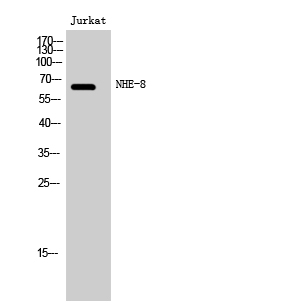NHE-8 Polyclonal Antibody
- 产品详情
- 实验流程
- 背景知识
Application
| WB, IHC-P |
|---|---|
| Primary Accession | Q9Y2E8 |
| Reactivity | Human, Mouse, Rat |
| Host | Rabbit |
| Clonality | Polyclonal |
| Calculated MW | 65422 Da |
| Gene ID | 23315 |
|---|---|
| Other Names | SLC9A8; KIAA0939; NHE8; Sodium/hydrogen exchanger 8; Na(+)/H(+) exchanger 8; NHE-8; Solute carrier family 9 member 8 |
| Dilution | WB~~Western Blot: 1/500 - 1/2000.IHC-p:1:50-300 ELISA: 1/20000. Not yet tested in other applications. IHC-P~~N/A |
| Format | Liquid in PBS containing 50% glycerol, 0.5% BSA and 0.09% (W/V) sodium azide. |
| Storage Conditions | -20℃ |
| Name | SLC9A8 (HGNC:20728) |
|---|---|
| Synonyms | KIAA0939, NHE8 |
| Function | Na(+)/H(+) antiporter. Mediates the electoneutral exchange of intracellular H(+) ions for extracellular Na(+) in 1:1 stoichiometry (PubMed:15522866). Acts as an Na(+)/H(+) exchanger in the trans-Golgi. Contributes to the regulation of pH regulation of Golgi apparatus, and consequently, in protein trafficking and endosomal morphology (PubMed:15522866, PubMed:20719963). In germ cells, plays a crucial role in acrosome biogenesis and sperm development, probably by playing a role in the fusion of the Golgi-derived vesicles that form the acrosomal cap (By similarity). Can also be active at the cell surface of specialized cells. In the small intestine, at the cell membrane, plays a major physiological role in transepithelial absorption of Na(+) and regulates intracellular pH homeostasis of intestinal epithelial cells (PubMed:34288721). Acts as an important regulator of mucosal integrity in the intestine and in the stomach, could mediate the pH fluctuation necessary for mucin exocytosis or assist membrane trafficking of other proteins (By similarity). Plays a role in photoreceptor survival and in the maintenance of intracellular pH homeostasis in retinal pigment epithelium (RPE cells) (By similarity). |
| Cellular Location | Golgi apparatus membrane; Multi-pass membrane protein. Golgi apparatus, trans-Golgi network membrane; Multi-pass membrane protein. Endosome, multivesicular body membrane; Multi-pass membrane protein. Apical cell membrane; Multi-pass membrane protein. Cytoplasmic vesicle, secretory vesicle, acrosome {ECO:0000250|UniProtKB:Q8R4D1} Note=Intracellular versus plasma membrane-resident location may vary with cell type. Mainly localized to the mid- to trans-Golgi compartments but a proportion is also localized to multivesicular bodies (PubMed:15522866, PubMed:20719963). Localized at the apical membrane of polarized gastrointestinal epithelial cells (By similarity). Recruitment to the plasma membrane upon acid stimulation (By similarity). {ECO:0000250|UniProtKB:Q4L208, ECO:0000269|PubMed:15522866, ECO:0000269|PubMed:20719963} |
| Tissue Location | Ubiquitous. Strongly expressed in skeletal muscle and kidney (PubMed:15522866). Detected throughout the entire gastrointestinal tract, with high expression detected in stomach, duodenum and ascending colon (PubMed:18209477) |
Research Areas
For Research Use Only. Not For Use In Diagnostic Procedures.
Application Protocols
Provided below are standard protocols that you may find useful for product applications.
BACKGROUND
Involved in pH regulation to eliminate acids generated by active metabolism or to counter adverse environmental conditions. Major proton extruding system driven by the inward sodium ion chemical gradient. Plays an important role in signal transduction.
终于等到您。ABCEPTA(百远生物)抗体产品。
点击下方“我要评价 ”按钮提交您的反馈信息,您的反馈和评价是我们最宝贵的财富之一,
我们将在1-3个工作日内处理您的反馈信息。
如有疑问,联系:0512-88856768 tech-china@abcepta.com.
¥ 1,500.00
Cat# AP71302























 癌症的基本特征包括细胞增殖、血管生成、迁移、凋亡逃避机制和细胞永生等。找到癌症发生过程中这些通路的关键标记物和对应的抗体用于检测至关重要。
癌症的基本特征包括细胞增殖、血管生成、迁移、凋亡逃避机制和细胞永生等。找到癌症发生过程中这些通路的关键标记物和对应的抗体用于检测至关重要。 为您推荐一个泛素化位点预测神器——泛素化分析工具,可以为您的蛋白的泛素化位点作出预测和评分。
为您推荐一个泛素化位点预测神器——泛素化分析工具,可以为您的蛋白的泛素化位点作出预测和评分。 细胞自噬受体图形绘图工具为你的蛋白的细胞受体结合位点作出预测和评分,识别结合到自噬通路中的蛋白是非常重要的,便于让我们理解自噬在正常生理、病理过程中的作用,如发育、细胞分化、神经退化性疾病、压力条件下、感染和癌症。
细胞自噬受体图形绘图工具为你的蛋白的细胞受体结合位点作出预测和评分,识别结合到自噬通路中的蛋白是非常重要的,便于让我们理解自噬在正常生理、病理过程中的作用,如发育、细胞分化、神经退化性疾病、压力条件下、感染和癌症。






